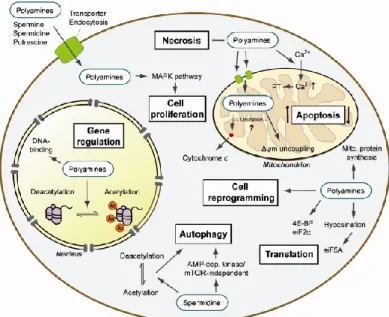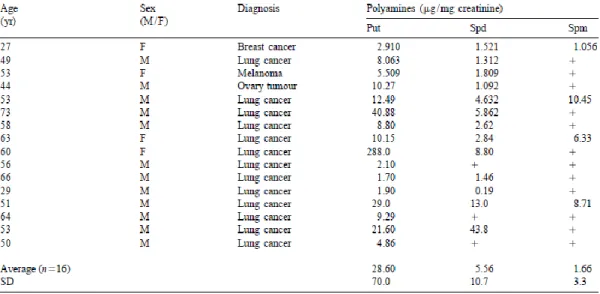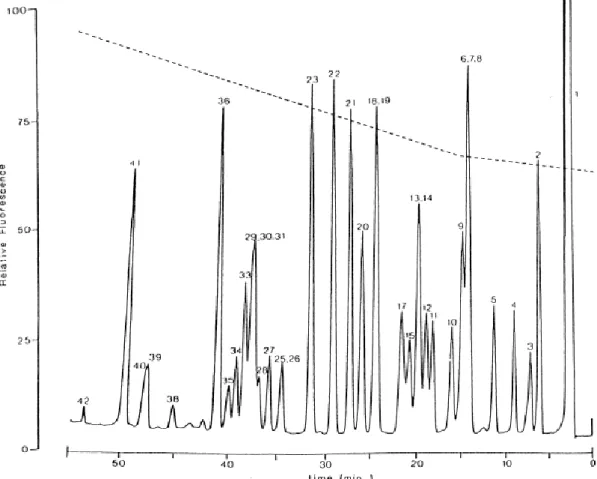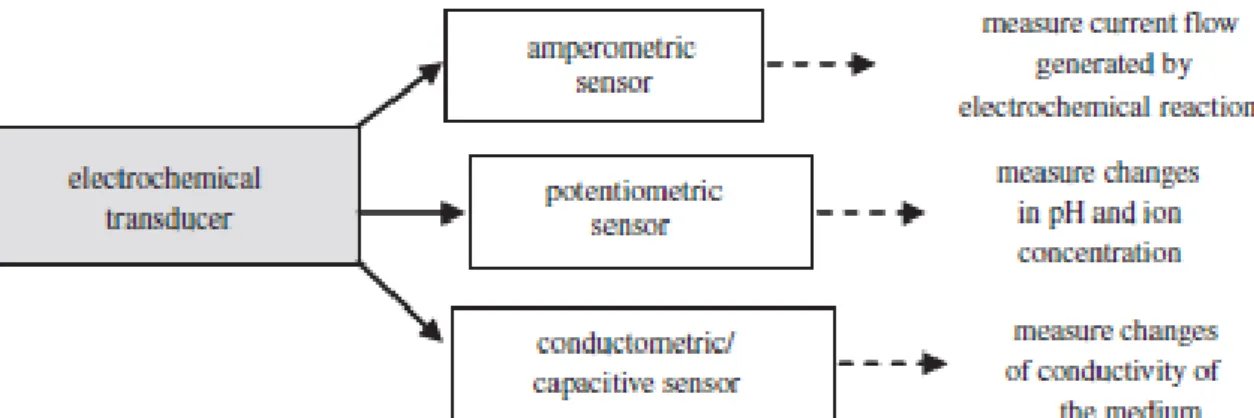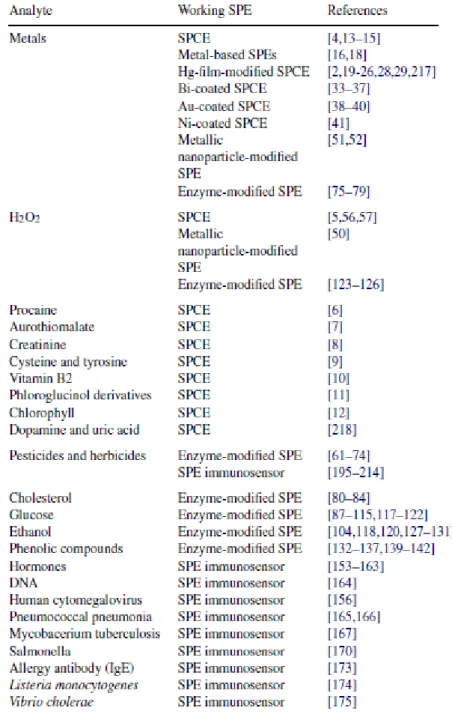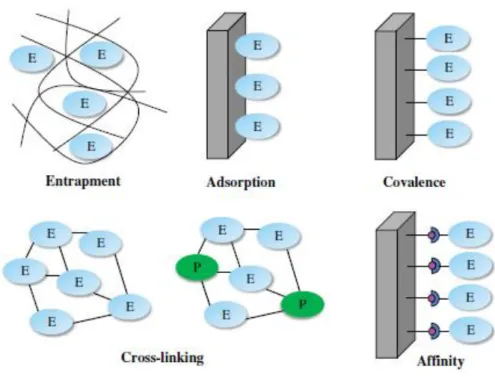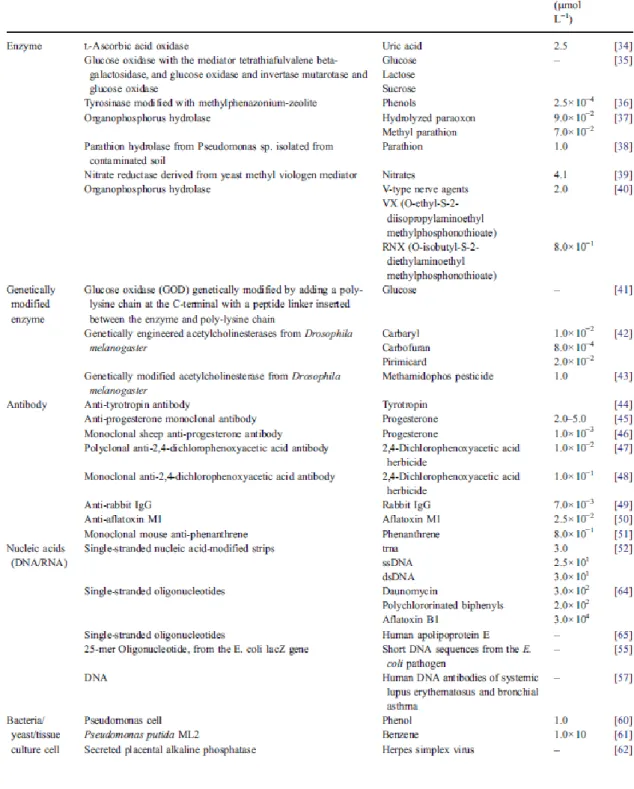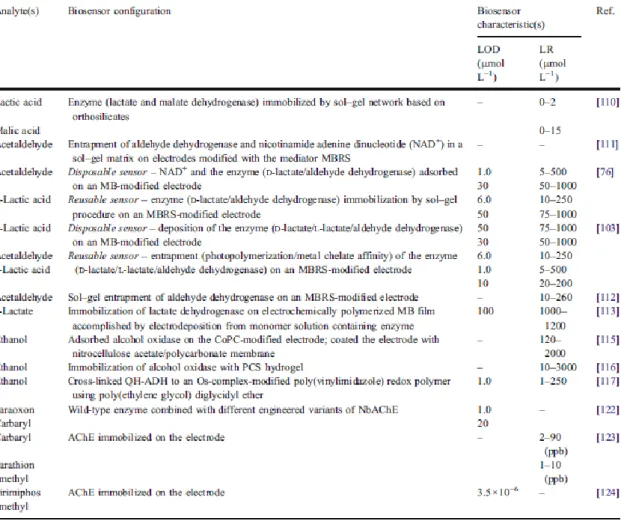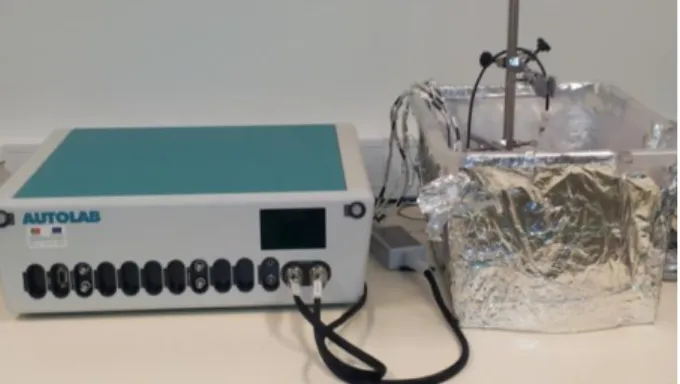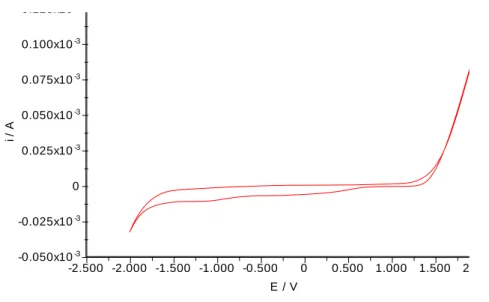i
UNIVERSIDADE DA BEIRA INTERIOR
Covilhã I Portugal
Enzymatic biosensors for spermidine
amperometric determination
Francisco Soares Marques
Dissertação para obtenção do Grau de Mestre em
Bioquímica
(2º ciclo de estudos)
Orientadora: Prof. Doutora María Julia Arcos Martínez
Co-orientadora: Prof. Doutora Ana Cristina Mendes Dias Cabral
ii
To my life women, Mum, Sister and Ticha
iii
Abstract
Polyamines (PA) detection has been shown of great interest as biomarkers for various analytical purposes, such as freshness of fish, fruit and vegetables and cancer control. Various methods have been developed for separation and quantification of biogenic amines and among then all, electrochemical biosensors. These types of biosensors, particularly the ones involving the screen-printing technology, which combine construction simplicity with biological recognition through enzyme specificity, have been reported as a good and cheap alternative to the traditional techniques. Screen-printing technology offers design flexibility, process automatization and good reproducibility in the transducers fabrication, as well as the possibility of using a wide choice of materials.
In this work, Monoamine Oxidase (MAO) and Diamine Oxidase (DAO) based biosensors using screen-printed carbon electrodes have been attempted for the determination spermidine. The enzymes have been immobilized onto the working electrode by means of glutaraldheyde and chronoamperometric variables (applied potential and solution pH) adjusted for better reply as experimental variables can affect biosensor chronoamperometric response.
One form of screen-printed electrodes (SPEs) modification consists of the incorporation of metallic nanoparticles on the working electrode surface. Due to their reduced size, metallic nanoparticles exhibit important physical and electrical properties which make them very useful for the construction of more sensitive electrochemical biosensors. Silver and gold nanoparticle-modified carbon SPEs show important advantages when they are used as working electrodes in electrochemical techniques. Thus, different experiments were performed using modified nanoparticles DAO/MAO biosensors in order to evaluate nanoparticles influence on detection limit, sensibility, repeatability and reproducibility.
Isothermal titration microcalorimetry (ITC) may be used as a tool for obtaining overall apparent molar enthalpy for catalytic reactions and enzyme kinetic constants. ITC is useful, in this regard, since it directly measures the heat change as catalysis proceeds and this is proportional to the rate of the reaction. ITC is a well established, powerful, versatile and high-sensitivity technique that is widely used for measuring the thermodynamics of equilibrium association reactions. In addition, well designed experiments can yield an approximate value for the equilibrium association constant for the enzyme-substrate complex (KA) when product formation is the limiting step, as well as the reaction stoichiometry (n).
Thus, this technique has been tried to study MAO activity when immobilized on a non-modified SPE.
Key words: Polyamines; Spermidine; Biosensors; Screen-printted electrodes; Nanoparticles;
iv
Resumo
Presentemente, diversos trabalhos têm demonstrado a utilidade das poliaminas (PA) como biomarcadores em várias técnicas de análise para a avaliação da qualidade dos alimentos (peixe, fruta e vegetais) e também no controlo do cancro. Vários métodos têm sido desenvolvidos para a separação e quantificação de aminas biogénicas, destacando-se de entre eles, o uso dos biosensores electroquímicos. Este tipo de biosensores, particularmente os que envolvem a tecnologia de electrodos serigrafados, combinam a simplicidade de construção com o reconhecimento biológico através da especificidade enzimática. A tecnologia de electrodos serigrafados oferece ainda flexibilidade de design, processos de produção automatizados, boa reprodutibilidade, e a possibilidade de uso de diversos materiais.
Neste trabalho, usando elétrodos de carvão serigrafados (SCE) imobilizados com oxidase da monoamina (MAO) ou oxidase da diamina (DAO) tentou-se construir um biosensor capaz de detectar espermidina. A imobilização das enzimas sobre o elétrodo de trabalho foi realizada por cross-linking usando glutaraldeído. Para uma melhor resposta eletroquímica, procedeu-se ao ajuste das variáveis cronoamperométricas (potencial aplicado e pH da solução) dado saber-se que estas podem interferir com a resposta electroquímica.
Uma forma de modificação dos SPE consiste na incorporação de nanopartículas metálicas na superfície do elétrodo de trabalho. Devido ao seu reduzido tamanho, as nanopartículas metálicas exibem propriedades elétricas e físicas importantes que as tornam vantajosas para a construção de biosensores eletroquímicos mais sensíveis. SCE modificados com nanopartículas de prata e ouro apresentam vantagens importantes quando são usados como elétrodos de trabalho em técnicas eletroquímicas. Assim, diversas experiências usando biosensores MAO/DAO modificados com nanopartículas, foram realizadas, para avaliar a sua influência no limite de deteção, na repetibilidade e na reprodutibilidade do método.
A técnica de titulação microcalorimétrica (ITC) pode ser usada como uma ferramenta na obtenção da entalpia molar aparente total de reações catalíticas e na obtenção dos parâmetros cinéticos das enzimas. Neste sentido, a ITC é útil, uma vez que mede diretamente a variação de calor durante a catálise, valor esse proporcional à velocidade de reação. A ITC é uma técnica, bem estabelecida, sensível, versátil e poderosa, que é amplamente usada na determinação da termodinâmica de reações associadas ao equilíbrio. Além disso, através de experiencias bem programadas pode-se obter um valor aproximado da constante de equilíbrio de associação para o complexo enzima-substrato (KA) quando o produto formado é o passo
limitante, bem como a estequiometria da reação (n). Portanto, tentou-se estudar a atividade enzimática da MAO quando imobilizada num SCE não modificado com nanoparticulas.
Palavras-Chave: Poliaminas; Espermidina; Biosensores; Electrodos Serigrafados;
v
Índice
Chapter I – Polyamines ... 1
1.1 PA characteristics ... 1
1.2 PA synthesis and functions ... 3
1.2.1 PA synthesis ... 3
1.2.3 PA Transport ... 6
1.2.4 PA in gene regulation ... 7
1.2.5 PA in autophagy... 8
1.2.6 PA effect on ion channels ... 9
1.2.7 PA catabolism ... 10
1.3 PAs in food ... 11
1.3.1 PAs in foods of plant origin ... 11
1.3.3 PAs in milk and its derivatives, human breast milk and eggs ... 15
1.4 PAs in health and diseases ... 15
1.4.1 Aging ... 15
1.4.2 PAs and stress ... 16
1.4.3 PAs and diseases ... 16
1.4.4 PAs and cancer ... 17
Chapter II - Analytical methods for PA determination ... 24
2.1 Planar chromatography ... 24 2.2 Gas chromatography ... 25 2.3 Liquid chromatography ... 25 2.4 Capillary electrophoresis ... 26 2.5 Biosensor ... 27 2.5.1 Thick-film biosensor ... 28 2.5.2 Non-biological components ... 30 2.5.3 Biorecognition elements ... 33
2.5.4 Immobilization of biorecognition element ... 34
Chapter III – Materials, apparatus and methods ... 39
vi
3.1.1 Fabrication of SPE ... 39
3.1.2 Stock solutions ... 39
3.2 Apparatus and software... 39
3.3 Methods ... 40
3.3.1 Preparation of SPEs ... 40
3.3.2 Metallic nanoparticles deposition on SPE ... 41
3.2.3 Enzyme immobilization ... 41
Chapter IV – Results and discussion ... 43
4.1. Sensitive diaminoxidase biosensor based on carbon SPE for Spd determination ... 43
4.1.1 First results and signal optimization ... 43
4.1.2 Figures of merit ... 52
4.1.3 Comparison with previous work ... 56
4.2. Sensitive monoaminoxidase biosensor based on carbon SPE for Spd determination .... 59
4.2.1 First results and signal optimization ... 59
4.2.2 Study of BSA/MAO concentration ratio effect on biosensor response ... 62
4.2.3 Study of GA/MAO concentration ratio effect on biosensor response ... 64
4.2.4 Figures of merit ... 69
4.3. Sensitive modified with Gold nanoparticles diaminoxidase biosensor based on carbon SPE for Spd determination ... 73
4.3.1 Figure of Merits ... 73
4.4. Sensitive modified with Gold nanoparticles monoaminoxidase biosensor based on carbon SPE for Spd determination ... 81
4.4.1 Figures of merit ... 81
4.5. Sensitive modified with Silver nanoparticles monoaminoxidase biosensor based on carbon SPE for Spd determination ... 86
4.5.1 Figures of merit ... 86
4.6 Biosensor enzymatic activity determination by isothermal titration microcalorimetry . 92 4.6.1 Introduction ... 92
4.6.2 Results Analysis ... 93
4.6.3 Experimental data ... 95
Chapter V – Conclusion ... 100
1
Chapter I – Polyamines
1.1 PA characteristics
Putrescine (put) (1,4-diaminobutane), spermidine (spd) (N-(3-aminopropyl)-1,4-diaminobutane) and spermine (spm) (N,N’-bis-(3-aminopropyl)-1,4-(N-(3-aminopropyl)-1,4-diaminobutane) (Figure
1.1.1) form a group of polycationic amines referred to as physiological Polyamines (PAs).
Traditionally they have been classified within the group of biogenic amines (BA) (Kalac and Krausová, 2005).
This PAs are a group of naturally occurring compounds exerting a large number of biological effects, yet despite several decades of intensive research work, the mode of action of the PAs at the molecular level is largely unknown (Bachrach et al., 2001; Igarashi and Kashiwagi, 2000; Janne et al., 1991; Seiler, 1990; Patocka and Kuehn, 2000; Russel, 1983). They bear unique structural features of regularly spaced positive charges interrupted by hydrophobic methylene bridges, as shown in Figure 1 and with particular chemical aspects as demonstrate in Table 1.1.1.
2
In 1678, van Leuwenhoek reported crystals in sperm samples when left to dry, which we now know were spm-phosphate crystals. In 1926, Dudley achieved spm synthesis, he also synthesized spd, and proved its existence in tissues (Dudley et al., 1926). Is not hard to understand that put had been isolated from tissues after bacterial decomposition (Brieger, 1879).
PAs like others substances could contribute to several damages in human organism if their intake is in an excessive way, so it is necessary to quantify PA toxicity. Therefore acute and subacute toxicity of the individual PAs was determined in Wistar rats. The acute toxicity was observed to be 2000, 600 and 600 mg/kg body weight for put, spd and spm, respectively. The no-observed-adverse-effect level (NOAEL) was 180, 83 and 19 mg/kg body weight for put, spd and spm, respectively (Til et al., 1997). However, such extreme intakes of dietary amines cannot be supposed.
During the last few years, spd and spm have been investigated as to their conformational behavior (Carvalho et al., 1999; Marques and Carvalho 2000; Marques et al., 2002a, b; Amorim da Costa et al., 2003, 2004; Marques and Carvalho, 2007). The conformational preferences of these linear alkylamines were found to depend on several factors, from steric, dipolar and hyperconjugative effects to the balance between intra- and intermolecular interactions. This kind of systems are characterised by a high conformational freedom (put, for instance, can adopt six different stable conformations), and by an interdependence of the particular effects due to the electronegativity and electron one-pairs of the nitrogen atoms. This constitutes an advantage for an effective interaction with biological receptors and lead to the formation of intra- and intermolecular hydrogen bonds which determine the solid-state conformational behaviour of the amines (Amado et al., 2004).
In addition, the dual hydrophilic–lipophilic character of the PA ligands, comprising cationic amine groups (both primary and secondary) and variable length hydrophobic alkyl linkers, will possibly lead to an enhanced cellular uptake. This hydrophilic–lipophilic balance depends on the relationship between the length of the carbon bridging chains and the number of amine moieties. In addition, the presence of NH groups will favor the molecular recognition of the PAs and PA-based agents by the polyphosphate backbone of DNA and related targets (e.g. purine bases) (Liu et al., 2006a).
3
The naturally occurring PAs are present in all prokaryotic and eukaryotic cells thus far studied. They stabilize nucleic acids and stimulate their replication. Spd and spm can bridge the major and minor grooves of DNA, acting as a clamp holding together either two different molecules or two distant parts of the same molecule (Feuerstein et al., 1986; Feuerstein et
al., 1989; Feuerstein et al., 1990; Feuerstein et al., 1991). However, the exact nature of the
PA–DNA interaction is not clearly established and is the subject of great controversy (Agostinelli et al., 2010). Furthermore, amines are known to be suitable chelating ligands for transition metal ions such as Pt(II) or Pd(II), yielding stable and usually water soluble coordination compounds, often active as pharmacological agents (e.g. anticancer drugs) (Agostinelli et al., 2010).
1.2 PA synthesis and functions
1.2.1 PA synthesis
The only PAs synthesized in mammalian cells are put, spd and spm (Gugliucci, 2004). Adequate cellular PA levels are achieved by a careful balance between biosynthesis, degradation, and uptake of the amines (Russell, 1983; Seiler, 1990; Jänne et al., 1991; Murakami et al., 1992; Tsirka e Coffino, 1992). PAs are bound to macromolecules (mainly nucleic acids) and this pool is in equilibrium with a free PA pool, which accounts for up to 7– 10% of the total cell content. Some of the regulatory mechanisms involved in maintaining a balance in the cellular PA pools are truly unique.
The PA biosynthetic pathway consists of two highly regulated enzymes: ornithine decarboxylase (ODC); S-adenosylmethionine decarboxylase (AdoMetDC); and two aminopropyltransferases, spd synthase and spm synthase, both constitutively expressed enzymes (Figure 1.2.1.1)
This pathway depends on adequate supply of ornithine, usually the product of the urea cycle arginase, which is then, in a way another key element for adequate PA synthesis. Another important element is the universal aminopropyl donor S-adenosyl methionine, a key coenzyme in this pathway.
Put is formed by the action of the dimeric form of the enzyme ODC (Pegg, 2006). This reaction is mediated by the using pyridoxal phosphate as a coenzyme, lysine residues play an important role in dimer stabilization and in the classic binding to the coenzyme (Osterman et
al., 1995a; Osterman et al., 1995b; Osterman et al., 1999). This enzyme is therefore a
critical step in maintaining PA levels and is exquisitely regulated. ODC is frequently described as the rate-limiting step in PA synthesis but this is inaccurate. ODC is usually the rate-limiting
4
factor in the production of put but the supply of the aminopropyl donor decarboxylated S-adenosylmethionine (dcAdoMet) by the action of AdoMetDC also influences the conversion of put into the higher PAs. Once converted to dcAdoMet, S-adenosylmethionine (AdoMet) is exclusively diverted to PA biosynthesis since methyl transferases do not use dcAdoMet as a substrate. The steady state level of dcAdoMet is therefore kept very low (c. 1–2% of the AdoMet content) and its supply limits the conversion of put to the higher PAs (Pegg, 2009). Recent structural and biochemical studies of mammalian AdoMetDC indicate that there is one put-binding site per (αβ) unit and that this site is located at a significant distance from the active site. Put binding to the (αβ)2 dimer that makes up the enzyme is quite strongly
cooperative and binding causes structural and electrostatic alterations at the active site (Bale
et al., 2008).
1.2.2 PA regulation
With important exception of the activation of AdoMetDC by put, PA content is controlled by changes in content of the key enzymes rather than by alterations in their activities by post-translational modifications or by binding effector molecules of low molecular weight.
Regulation of ODC
The regulation of ODC is complex, showing features that do not always fit into the generally accepted rules of molecular biology. ODC activity appears to be regulated solely via changes in the amount of ODC protein rather than modification of its catalytic activity. The regulation of ODC is not mediated by posttranslational or allosteric mechanisms. Instead, its steady-state concentration depends mainly on transcription, mRNA translation, mRNA stability and catabolism (Osterman et al., 1994; Osterman et al., 1999; Pegg, 2006; Shantz and Levin, 2007).
The PA biosynthetic enzyme ODC is degraded by the 26S proteasome via an ubiquitinin-dependent pathway in mammalian cells (Murakami et al., 1992; Tsirka e Coffino, 1992). Its degradation is greatly accelerated by association with the PA-induced regulatory protein antizyme 1 (AZ), which binds to ODC, inhibits its activity, and targets it for proteasome degradation. AZ synthesis is increased in response to high PA levels predominantly via increasing a +1 frameshifting mechanism, which is needed to allow read through of a stop codon that prevents AZ synthesis (Petros et al., 2005; Ivanov and Atkins, 2007). A second protein termed AZIn binds to AZ more tightly than ODC and can displace it and thus prevent the degradation. The structure of AZIn is quite similar to that of the ODC monomer but it lacks catalytic activity and is monomeric (Albeck et al., 2008). This unusual pathway remains an exception only found so far in PA metabolism (Pegg, 2009).
5
F ig u re 1. 2. 1 .1 - Pol ia m ine Met ab oli sm . Mi no is e t al. , 20 116
Regulation of AdoMetDCIn addition to the activation of AdoMetDC proenzyme processing and enzyme activity by put, the amount of AdoMetDC protein is highly regulated to maintain cellular PA levels at multiple steps including transcription, mRNA translation and protein turnover (Stanley, 1995; Pegg et
al., 1998). The amount of AdoMetDC is negatively regulated by increased spd/spm content at
all three of these steps. Degradation of AdoMetDC requires polyubiquitination (Kahana, 2007). Reduction of PA content in response to various drugs causes a marked increase in the half-life of AdoMetDC protein (Pegg et al., 1998; Kahana, 2007).
Regulation of Aminopropyltransferases
Synthesis of the higher PAs is brought about by aminopropyltransferases termed spd synthase and spm synthase (Ikeguchi et al., 2006) (Figure 1.2.1.1). Despite the close similarity of their of their reactions, human Spd synthase and Spm synthase are distinct enzymes and show strict substrate specificity (Wu et al., 2007; Wu et al., 2008). Both structures contain two fully conserved key aspartic residues (Asp104 and Asp173 in Spd synthase; Asp201 and Asp276 in Spm
synthase) that play a key part in the catalytic mechanism.
It is generally accepted that the formation of the products of these enzymes is determined by the availability of the substrates rather than by fluctuations in the levels of spd synthase or spm synthase (Pegg, 2009).
1.2.3 PA transport
Polyamine-specific carriers are widely distributed in prokaryotes and eukaryotes. Mammalian polyamine transport activity is also acutely controlled by cell cycle events and hormonal stimulation. Polyamine transport is a saturable, carrier-mediated, and energy-dependent process (Igarashi and Kashiwagi, 1999)
There are transport systems for both the uptake of polyamines and for their efflux. These are currently poorly understood at the biochemical level. The PA transport system is not highly specific and can transport a number of related compounds including paraquat, mepacrine and synthetic drugs conjugated with a polyamine (Rossi et al., 2008; Kaur et al., 2008). These may prove to be useful drugs for cancer chemotherapy when administered together with inhibitors of the biosynthetic pathway (Burns et al., 2009).
Cell surface heparin sulfate proteoglycans have been implicated in PA transport, and uptake of PAs was blocked by a single chain variable fragment anti-heparan sulfate antibody (Welch
et al., 2008). Recently, a caveolin-regulated system has been shown to transport PAs in colon
7
et al., 2008). Such phosphorylation was stimulated by k-Ras providing another step at which
this oncogene may increase cellular PAs.
Recent studies have identified SLC3A2, previously known as a glycosylated heavy chain of a cationic amino acid transporter, as a part of a put and acetylpolyamines efflux system. SLC3A2 with its partner y+ LAT light chain was found to bring about arginine uptake and put efflux (Uemura et al., 2008). This efflux was coupled to arginine uptake suggesting that there is a put/arginine exchange reaction. The expression of SLC3A2 was negatively regulated by k-Ras (Uemura et al., 2008). Thus, this oncogene can increase PA content by affecting both influx and efflux. Alternatively, it is thought that PA uptake in mammals could be performed by endocytosis (Minois et al., 2011).
1.2.4 PA in gene regulation
PAs are strongly positively charged at physiological pH and bind to acidic sites on cellular macromolecules including proteins, nucleic acids and phospholipid membranes (Pegg, 1988; Childs et al., 2003; Sarkar et al., 2009). All of these interactions are likely to have some physiological effect (Figure 1.2.4.1).
It is clear that PAs affect RNA and DNA structure, ribosome function, and the activity of many enzymes including kinases and phosphatases. PA response elements have been identified in some genes (Childs et al., 2003; Casero and Marton, 2007) and the transcription of many genes appears to be influenced through the PA status (Pegg, 1986; Pegg, 1988; Wallace et al., 2003; Childs et al., 2003; Jänne et al., 2004). These genes include transcription factors such as c-Myc and c- Jun (Liu et al., 2006b; Xiao et al., 2007), which can lead to additional signaling pathways. Similarly, PAs selectively influence the translation of many mRNAs; examples include the effects on AZ, AdoMetDC and SSAT synthesis (Pegg, 2009).
8
PA-related alterations in cell:cell interactions mediated via cadherins (Liu et al., 2009) or Toll-like receptors (Chen et al., 2007), effects on the cytoskeleton mediated by changes in the activity of G-proteins such as Rac1 and RhoA (Vaidya et al., 2005; Ray et al., 2007; Mäkitie et al., 2009), and alterations in the microtubule network (Mechulam et al., 2009) are also possible sites of physiological PA action.
High PA levels alter histone acetylation and histone acetylases and deacetylases activities in proliferative cells (Minois et al., 2011).
Another finding is that PAs facilitate oligomerization of nucleosomal arrays in vitro, and that PA-mediated chromosome condensation is inhibited by histone hyperacetylation (Pollard et
al., 1999). These results suggest that PAs are repressors of transcription in vivo, and that one
role of histone hyperacetylation is to antagonize the ability of PAs to stabilize highly condensed states of chromosomal fibers (Igarashi and Kashiwagi, 2010)
A screen for the loss of effect of spd on life span in yeast showed that the hypoacetylation by spd was mainly due to an inhibition of histone acetylases rather than activation of histone deacetylases. Taken together, the results showed that PAs affect acetylation, which in turn will affect gene regulation.
It thus seems that PAs, by modulating acetylation levels and protein synthesis, will trigger varied changes that can potentially lead to complex cellular responses. Such actions of PAs may help explain how they can promote both cell growth and cell death and can show such a complex involvement in aging, stress and diseases (Minois et al., 2011).
1.2.5 PA in autophagy
Autophagy is the mechanism responsible for the degradation of intracellular macromolecules and organelles. Autophagy is an essential function in development and survival as it will dispose of unwanted molecules such as damaged molecules during stress, aging or diseases, or during developmental remodeling. Autophagy is involved in many diseases (Levine and Kroemer, 2008; Mizushima et al., 2008; Fleming et al., 2011). Many genetic and non genetic manipulations increasing life span induce autophagy (Madeo et al., 2010a) and it appears as a point of convergence of many genetic pathways involved in aging (Markaki et al., 2011). It was demonstrate that induction of autophagy was probably the main mechanism of action of spd to trigger its beneficial effects on life span and aging (Eisenberg et al., 2009; Morselli et
9
1.2.6 PA effect on ion channels
Glutamate receptors
PAs influence glutamate receptors mediating slow voltage-dependent responses such as N-methyl-D-aspartate (NMDA) receptors, and those producing fast responses at excitatory synapses, such as a-amino-3-hydroxy-5-methyl-4-isoxazolepropionic acid (AMPA) receptors and kainate receptors (Dingledine et al., 1999).
The NMDA receptors are involved in synaptic plasticity and may also play a role in seizure activity. Spm (and, to a lesser extent, spd) has multiple effects on these receptors including stimulation and a weak voltage-dependent inhibition representing an open-channel block. Spm stimulation, which occurs at 1 M concentrations, causes an enhancement of the current gated by glutamate and glycine. There is a ‘glycine-dependent stimulation’, which produces an increase in the affinity of the receptor for glycine. Binding of spm can also produce a ‘glycine-independent stimulation’ at saturating concentrations of glycine.
The AMPA-type glutamate receptors are responsible for fast excitatory neurotransmission in the CNS. They are heteromeric ligand-gated channels composed of four possible subunits (GluR1-4) whose properties depend on the presence of GluR2. Those lacking the GluR2 subunit are permeable to Ca2+ ions, possess a high single-channel conductance, and are subject to a
block by endogenous intracellular PAs (predominantly spm) that confers profound rectification on the responses and influences frequency-dependent facilitation at synapses expressing these receptors. Thus, PAs may regulate the amount of Ca2+ flux and the
excitability threshold at developing synapses (Pegg, 2009). PAs may also affect the activity via interactions with protein kinase C (Shin et al., 2007).
Kir Channels
The inward rectifier potassium channel gene family consists of seven subfamilies (Kir1-7). Voltage-dependent block by intracellular PAs is the common mechanism underlying the inward rectification in all the Kir channels. All of the natural PAs can bind and have some effects in experimental conditions but the affinity increases from put to spd to spm (Stanfield and Sutcliffe, 2003; Guo and Lu, 2003).
10
1.2.7 PA catabolism
Catabolism of PAs is less well characterized (Seiler, 1975; Seiler, 1985; Kusche et al., 1985; Seiler, 1990).
Several enzymes are involved in the reversal of the aminopropyltransferase reactions, which like the decarboxylases are effectively irreversible (Seiler, 2004; Wang and Casero, 2006; Pegg et al., 2008). Spermine oxidase (SMO) converts spm to spd plus 3-aminopropanaldehyde but does not act significantly on spd (Wang and Casero, 2006). Acetylpolyamine oxidase (APAO) converts N1-acetylspermidine into put plus N-acetyl-3-aminopropanaldehyde (Wang et
al., 2005; Takao et al., 2009; Henderson Pozzi et al., 2009). APAO also acts on efficiently on
N1-acetylspermine to form spd (Pegg, 2009). The substrates for the APAO reaction are synthesized by the action of spd/spm-N1-acetyltransferase (SSAT) (Pegg, 2008). SSAT acetylates both spm and spd. Acetylated spm and spd then move into the peroxisome where they are oxidized by Polyamine oxidase (PAO) (FADdependent). By-products of this oxidation include hydrogen peroxide (H2O2) and acetaminopropanal. (Nadège Minois et al., 2011). The
net results of the SMO and APAO/SSAT reactions are to convert the higher PAs to put, which is more readily excreted from the cell and can also be degraded by diamine oxidase. Therefore, activation of these pathways can reduce PA content. Studies with transgenic mice that overexpress SSAT have provided convincing demonstrations that this enzyme is an important regulatory step in maintaining PA content (Jänne et al., 2006; Niiranen et al., 2006; Jell et
al., 2007). In addition cytosolic SSAT is the rate-limiting enzyme of PA catabolism (Figure
1.2.1.1).
Both APAO and SMO are flavoproteins that generate reactive aldehydes and H2O2 and may
cause oxidative damage. This may be a more serious problem with SMO since APAO is located in peroxisomes (Pegg, 2009). Products from both the SMO and APAO reactions, as well as acrolein, a highly toxic product of spm oxidation formed after cell damage by extracellular copper-dependent oxidases (Yoshida et al., 2009), have been linked with renal failure (Igarashi et al., 2006) and stroke (Tomitori et al., 2005).
11
1.3 PAs in food
PAs are present in various types of food such as: vegetables, meat and its products, fish and milk as well as its derivatives.
1.3.1 PAs in foods of plant origin
Put, spm and spd universally occurring in plant organs are involved in a wide array of processes, ranging from triggering organogenesis to protecting against stressPut contents are commonly the highest among PAs. Some of the tested foods (Table 1.3.1.1 and 1.3.1.2) have a considerably high mean put level (above 40 mg kg-1), namely oranges, orange juice,
mandarins, grapefruit juice and the processed foods sauerkraut, ketchup, frozen green peas and fermented soy products. Spd contents in plant foods are commonly higher than spm levels. Legumes, mainly soybean, pear, cauliflower and broccoli belong to food items with the highest spd content, usually above 30 mg kg-1. The same foods, mainly legumes, also have the
highest spm levelA proportion of PAs leaches to cooking water. For put, approximately 20–25% leaches from broccoli and celery and about 40% from cauliflower and asparagus. Similarly for spd, 10–20% leaches from broccoli, savoy and celery, and 20–30% from cauliflower and asparagus (Ziegler et al., 1994). PA contents also may change during the storage of fresh vegetables. Simon-Sarkadi et al. (1994) observed changes in PAs during the storage of fresh Chinese cabbage, endive, iceberg lettuce and radicchio at 5 ºC over five days. The put content increased 3–8-fold during this period, while spd and spm levels did not change significantly.
12
Table 1.3.1.1 – Content of polyamines (mg kg-1) in potato, vegetables and fruits.
13
1.3.2 PAs in meat, fish and meat products
In contrast to foods of plant origin, low levels of put are typical for well-treated foods of animal origin (Table 1.3.2.1). Fish sauces, cod roe and canned crab are the reported exceptions. High spm contents, usually between 20 and 60 mg/kg, are usual in meat and meat products of warm-blooded animals. Lower spm contents, commonly below 10 mg kg-1, were
reported in fish. Spd levels in meat and fish rarely exceed 10 mg kg-1. Thus, an opposite
relation between spd and spm contents is typical for foods of animal origin as compared with plant products. Silva and Glória (2002) explain higher spd than spm contents in their samples of chicken-based meat products by the incorporation of a considerable proportion of vegetable components.
Yano et al. (1995) observed a considerable increase of put content over 13 days of storage, while no changes in spd and spm contents during storage up to 39 days in vacuum-packed beef sirloin at 0, 5 or 10 ºC. In a classical work, Mietz and Karmas (1978) included PAs as indicators of seafood decomposition. They observed that spd and spm contents decreased during storage, while put content increased. In recent years, similar changes were observed in Mediterranean hake. Put content increased significantly during storage for 29 days, being more intensive at 6–8 ºC than at 0 ºC (in ice). Spd and spm contents somewhat decreased from the initial levels 4 and 10 mg kg-1, respectively (Baixas-Nogueras et al., 2002). Similarly,
an extensive formation of put and a slight decrease of spd content were determined in carp
14
meat, while spm content remained stable during storage at 3 or 15 ºC until spoilage (Krízek et
al., 2002).
Table 1.3.2.1 - Content of polyamines (mg kg-1) in beef, pork and chicken meat, meat products
15
1.3.3 PAs in milk and its derivatives, human breast milk and eggs
Levels of all PAs are very low in cow milk, yoghurt, human milk and hen eggs. However, contents of all PAs can reach an extremely high level in cheeses, mainly in matured types. The PA contents in human milk were reviewed by Löser (2000). Content of PAs varies during the suckling period. During the first week postpartum, put levels remained very low, while spd and spm contents rose markedly during the initial three days, reaching plateau levels that were 12 and 8 times higher, respectively, than the values determined on the initial day of lactation. After four months of lactation, put content slightly increased, whereas spm and spd contents remained almost stable (Romain et al., 1992). Mothers seem consistently to have relatively high or relatively low contents of spd and spm in their milk. These individual variations may be due to diet, lifestyle or genetic background (Dandrifosse et al., 2000). Spd and spm contents in infant powdered formulas were observed to be considerably lower than values usual in breast milk (Buts et al., 1995; Romain et al., 1992).
1.4 PAs in health and diseases
1.4.1 Aging
PA levels decrease with age in many organisms (Scalabrino and Ferioli, 1984). For instance, Nishimura et al. (2006) measured PA levels in 14 different tissues in 3, 10 and 26 week-old female mice and found that spd levels decreased in 11 out of the 14 tissues. In contrast, spm decreased only in skin, heart and muscles. Put levels were very low in all tissues at all ages. Vivó et al. (2001) reported a negative correlation between spd content and age in several areas of the basal ganglia in human brains and a similar trend for spm.
Soda et al. (2009) fed male mice a low, normal or high-PA chow. They showed that mortality in mice fed a high-PA chow was lower in the first 88 weeks. The authors also reported a lower incidence of age-related kidney glomerular atrophy kept on high-PA diet. Finally, they observed that old mice on high-PA chow kept a thicker coat with age and appeared more active. These results are promising and further studies in rodents are urgently required. Spd increased chronological life span in wild-type yeast as well as remaining replicative life span in old yeast cells. Was also showed that spd supplementation increased life span in the nematode worm Caenorhabditis elegans by 15% and in the fly Drosophila melanogaster by up to 30%. At the cellular level, spd increased survival of human peripheral blood mononuclear cells after 2 days from 15% in the controls to 50% by preventing death from necrosis. These results strongly suggest that spd could represent a new preventive agent in our fight against
16
aging (Minois et al., 2011). However, so far research has mainly focused on the effect of spd on life span and not on the importance of its effect.
1.4.2 PAs and stress
Various studies showed that PAs had important roles in and generally correlate with stress resistance. PAs are particularly important for adaptation and resistance to cold stress (Alcázar
et al., 2011) and PA levels increase in plants during abiotic stress such as salinity, extreme
temperature, paraquat or heavy metals. This regulation of PAs under stress is achieved by differential expression of PA biosynthesis enzymes, such as arginine decarboxylase, spd and spm synthase or AdoMetDC. Exogenous application of PAs led to, in varying degrees, preserved membrane integrity and lower growth inhibition during stress, reduced accumulation of ROS and increased activity of antioxidant enzymes such as catalase. In contrast, PA synthesis inhibitors triggered decreased stress resistance.
1.4.3 PAs and diseases
As regulators of cell growth and death, it is likely that PAs may affect the severity and process of diseases. PA levels increase in many diseases. As PAs also regulate growth in pathogens, they may have an impact on infectious and parasitic diseases as well. However, as for aging and stress resistance, PAs have different effects in different models and on different diseases (Minois et al., 2011).
More than 90% of circulating spd and over 70% of spm are associated with red blood cells. Gomes-Trolin et al. (2002) observed that in red blood cells, put levels decreased in Parkinson’s disease and amyotrophic lateral sclerosis patients. In contrast, spd and spm increased in both sets of patients. There was no correlation between the levels measured and the severity of the disease. Earlier, Yatin et al. (1999) suggested a possible involvement of PA metabolism in Alzheimer’s disease.
For instance, spm exacerbated ischemic neuronal injury in rodent models of ischemia (Duan
et al., 2011). However, no such damaging effect was observed with put or spd. Spm also
increased neuronal damage in culture rat hippocampal neurons induced by oxygen and glucose deprivation. In contrast, PAs can also be neuroprotective (Bell et al., 2011).
PAs are also important in diseases such as pancreatitis. The pancreas is the organ where the highest levels of spd are observed in mammals. Transgenic rats overexpressing SSAT exhibited a depletion of spd and spm and developed pancreatitis. Furthermore, these rats failed to initiate liver regeneration after partial hepatectomy. Liver regeneration could only begin once the spd levels were restored because of ODC activation.
17
Many diseases are associated with inflammation and PAs have been involved in inflammatory responses. PA levels generally increase with inflammation (Minois et al., 2011).
Put and spm induced the accumulation of tumor necrosis factor (TNF) and mixed glial cultures. Spd did not have such an effect. The authors concluded that ODC expression was an early response to inflammation and that the increased PA levels resulting from ODC activation could lead to pro- or anti-inflammatory roles depending on the microenvironment. The potential anti-inflammatory role of PAs, which also lead to the production of nitric oxide, has led Soda to hypothesize that PA uptake may help with cardiovascular diseases (Soda, 2010). Recently, spd was shown to be beneficial against two age-related diseases: cataract formation (Lentini et al., 2011) and multiple sclerosis (Guo et al., 2011). To conclude, PAs have a complex relationship with diseases. They may be harmful, neutral or beneficial, depending on the specific PA and disease. However, it seems that spd showed the most positive effects, which would be in line with its beneficial effects reported on life span and stress.
1.4.4 PAs and cancer
The PAs metabolism is of much interest as they are required for cell growth and proliferation. High levels of PAs are therefore observed in rapidly divided cells and tissues such as tumour cells (Russell, 1983; Gerner and Meyskens, 2004; Erdman et al., 1999). Gene expression and activity of enzymes involved in PA biosynthesis, especially ODC, are higher in cancer tissues than in normal surrounding tissues (Kingsnorth et al., 1984; LaMuraglia et al., 1986; Becciolini
et al., 1991; Canizares et al., 1999; Linsalata et al., 2002).
A strategy to study the involvement of PAs in cancer has been to use PA biosynthesis pathway inhibitors or PA analogues. Drugs interfering with PA biosynthesis or their biological role thus have considerable potential as therapeutic agents. Investigated chemopreventive or anti-neoplastic agents include ODC inhibitors (Seiler, 2003a) and PA structural analogues and derivatives (Seiler, 2003b). However, tumour cells have the ability to uptake extracellular PAs, both dietary and produced by gastrointestinal bacteria, and compensate effects of the mentioned therapeutic agents. Many reviews and papers have gathered the knowledge on this field (Wallace et al., 2003; Wallace and Fraser, 2004; Casero and Marton, 2007; Amendola et
al., 2009; Senanayake et al., 2009; Szumilak et al., 2010; Babbar and Gerner, 2011). The ODC
inhibitor DL-α-difluoromethylornithine (DFMO) was the first one synthesized and studied. This compound showed no effect during clinical trials, and is currently being studied as a chemopreventive agent rather than a chemotherapeutic one (Casero and Marton, 2007). DFMO and other compounds like methylglyoxal-bis guanylhydrazone (MGBG), an inhibitor of S-Adenosylmethionine (SAM), became key tools in the elucidation of the PA metabolic system, but only few of them were efficient as inhibitors of tumor growth (Tabor and Tabor, 1984;
18
Herr et al., 1986; Erdman, 1990; Wang et al., 1993; Davis et al., 2001). It has been claimed that DFMO may improve the efficacy of some of the existing cytotoxic drugs.
Another approach thus started in the 1990s – deprivation of exogenous PAs (Quemener et al., 1994). PA deprivation, combining the inhibition of PA synthesis in tumour cells and reduction of the main exogenous sources including food and microflora-derived PAs, has shown to be a promising therapeutic strategy. Stimulation of the antitumoural immune response is an additional effect of PA deprivation (Catros-Quemener et al., 1999). However, it has not yet been experimentally proved that altering of the dietary PA intake can help cancer patients (Kalac and Krausová, 2004).
Numerous reports have shown that both blood and urine PA concentrations (Table 1.4.4.1) are often increased in cancer patients (Uehara et al., 1980; Kubota et al., 1985; Weiss et al., 2002; Linsalata et al., 2002). Moreover, these levels decrease after tumor eradication and increase after relapse (Loser et al., 1990; Chatel et al., 1987; Kubota et al., 1985; Uehara et
al., 1980; Kingsnorth et al., 1984).
A number of studies have indicated higher concentration of Put, Spd and Spm or total PA contents (free and acetylated) in cancer patients compared to healthy subjects (Matthews, 1993; Russell, 1971; Tang et al., 1994; Nishioka et al., 1995; Chanda and Ganguly, 1995; Chowdhury et al., 1995; Suh et al., 1995). Lee et al. (2008) observed higher mean levels of PAs in serum of uterine cancer patients than those in normal serum. Suh et al. reported significant differences in urinary PAs in advanced gastric carcinoma, ovarian cancer, acute myelocytic leukemia, non-Hodgkins lymphoma as compared to healthy subjects. In solid tumors the activity of ODC and AdoMetDC is higher compared to normal tissue (Russel et al., l983; La Muraglia et al., 1986; Heby and Person, et al., 1990; Porter et al., 1987). Consequently, the concentrations of Put and Spd are also enhanced considerably (Upp et al., 1988). Peng et al. reported that total PAs, especially the contents of Cad and Spd in malignant ascites were significantly higher as compared to the patients with cirrhosis and tuberculosis suggesting that ascite levels of PA can be regarded as one of the cancer markers. Chowdhury et al. explored the relation between PA spectrum and the degree of malignancy in human breast cancer patients. The results showed that PA levels varied with clinical staging of the disease and bore a direct relationship to the degree of the disease.
In the responding patients, PA levels are shown to normalize when the patient is in remission. On the other hand, patients with a recurrent tumor or metastatic disease show higher PA excretion, thus the response of an individual can be monitored (Wallance, 1996; Russel et al., l983; Russell, 1977; Wan et al., 1990). Nonresponders of the chemotherapy tended to show elevated Put without any significant increase in Spd. The plot of post to pretreatment Spd ratio over post to pre Put ratio had value of 1.4 for complete responders, 1.2 for partial
19
responders and 0.4 for nonresponders (Russel et al., l983). Bakowski et al. observed that patients undergoing remission induction chemotherapy showed a significant elevated plasma Spd level within 48 h and suggested that tumor response to chemotherapy can be predicted on the basis of plasma PAs.
PAs and cancer spread
Cancer cells maintain their proliferative capacity by the interaction of PAs with oncogenes (Gerner and Meyskens, 2004). Growth-associated genes, such as c-fos and c-myc proto-oncogenes, are activated during cellular proliferative processes (Davis et al., 2001). Likewise, malignant transformation leads to an increase in PA biosynthesis, deregulation of ODC, and the amplification of proto-oncogenes (Erdman, 1990; Herr et al., 1986; Davis et al., 2001; Wang et al., 1993; Tabor and Tabor, 1984).
Patients with increased PA levels either in the blood or urine are reported to have more advanced disease and worse prognosis compared to those with low levels, regardless of the type of malignancy (Kubota et al., 1985; Uehara et al., 1980; Weiss et al., 2002; Linsalata et
al., 2002). Therefore, inhibition of PA synthesis and availability by cancer cells could retard
cancer cell growth.
a) The role of PAs on separation of cancer cells from the tumor cluster
This separation is initiated by decreased cell adhesion (Figure 1.4.4.1). Hypoxia, a common condition in cancer tissues, exerts a strong pressure on cells to separate from the tumor cluster and migrate into circulation (Klymkowsky and Savagner, 2009; Pouyssegur et al., 2006). The cellular response to hypoxia involves the stabilization and resultant increase in
Table 1.4.4.1 - Determination of polyamines in urine from cancer patients. Adapted from Khuhawar
20
levels of hypoxia inducible factor-1 (HIF-1), a transcription factor that enhances gene expression to promote angiogenesis, anaerobic metabolism, cell survival, and invasion (Harris, 2002). Among these, suppression of adhesion molecules induced by hypoxia-induced HIF-1 stabilization is a strong selective pressure that enhances outgrowth of cells with high-grade malignancy. CD44 and E-cadherin are adhesion molecules whose expression decreases in response to hypoxia (Beavon, 1999; Hasan et al., 1998). Reduced CD44 expression is reported to promote cancer metastasis and invasion, allowing detachment of cancer cells from the primary tumor cluster and seems to contribute to the increased migration capacity of hypoxic HT-29 cells (De Marzo et al., 1998; Kallakury et al., 1996).
In cells exposed to chronic hypoxia, PA synthesis is decreased, while the ability to take up PAs from the surroundings is increased (Tantini et al., 2006; Aziz et al., 1994). It has been reported that cancer cells under hypoxia lose regulation of PA homeostasis and have increased PA uptake from surrounding tissues (Figure 1.4.4.1) (Tsujinaka et al., 2011). Several experiments indicated a possible role for PAs in the invasive potential of cancer cells (Jun et al., 2008; Manni et al., 2005; Sunkara and Rosenberger, 1987).
b) Role of PAs in cancer cell transmigration to the circulation
Cancer invasion is the process in which cancer cells migrate through surrounding tissues and enter into a blood vessel, which enables cancer cells to be transported throughout the body and establish secondary tumors (Soda, 2011).
Figure 1.4.4.1 – Mechanism of cancer metastasis. A) Progression and development of
metastasis; B) Cancer cells exchange polyamines to the surroundings to stimulate other cancer cells under hypoxia. Adapted from Soda, 2011
21
Cancer cells have the ability to create new blood vessels in the tumor, i.e. angiogenesis, so that cancer cells can obtain supplies of blood and oxygen (Dvorak et al., 2011). Increased PA synthesis appears to be accompanied by cancer invasiveness as ODC overexpression enhances the invasive characteristics of cancer cells (Kubota et al., 1997). In contrast, inhibition of PA synthesis by the ODC inhibitor DFMO attenuates the invasive characteristics of cancer cells (Jun et al., 2008; Manni et al., 2005; Ashida et al., 1992), and supplementation with PA reverses the DFMO-induced decrease in invasive qualities (Ashida et al., 1992). The close correlation between increased PA synthesis and increased matrix metalloproteinases (MMP) synthesis has also been shown using DFMO, which caused decreases in cancer cell expression and concentrations of MMPs, such as matrilysin, meprin, and MMP-7 (Wallon et al., 1994; Matters et al., 2005).
c) Possible role of PAs on cell rooting and colonization at secondary tumor sites
Cancer cells that invade blood vessels and escape from immune system detection in circulation anchor to endothelial vasculature to establish new sites of growth. Upon vessel entry, cancer cells have access to abundant oxygen supplies that could enable cancer cells to restore their original activities such as increased gene expression that translates to enhanced enzymatic activities for PA synthesis, proteinase, and angiogenesis factors. The expression of CD44 of normoxic cancer cells is higher than that of hypoxic cells (Tsujinaka et al., 2011), suggesting that the circulating cancer cells possibly recover their original adhesion characteristics. They invade and rapidly grow because of their increased capacity to synthesize PAs indispensable for cell growth and proteins that degrade the tissue matrix and create new vessels (Soda, 2011).
d) PAs help cancer cells escape immune system detection
Immune suppression, often observed in cancer patients, accelerates cancer spread. Various defects in cellular functions indicative of immune suppression have been reported, including attenuated adhesion properties of peripheral blood mononuclear cells (PBMCs) (Hersh et al., 1982; Grosser et al., 1976; MacFarlane et al., 1982), impaired production of tumoricidal cytokines and chemokines (Heriot et al., 2000; Rampone et al., 2001; Monson et al., 1986), and decreased cytotoxic activity of killer cells, especially lymphokine activated killer (LAK) cells (Wood et al., 1990; Herman et al., 1990; Funk et al., 2005; Balch et al., 1985). Animal experiments have shown that PA deprivation prevents the development of tumor-induced immunosuppression (Chamaillard et al., 1997).
The time- and dose-dependent decrease in adhesion produced by PAs was accompanied by decreases in the expression of lymphocyte function-associated antigen-1 (LFA-1), which consists of an integrin alpha L (CD11a) and beta 2 (CD18) chain (Soda et al., 2005). PAs in particular decrease the number of cells expressing bright CD11a. In addition, the number of CD56 bright cells was decreased by PAs in vitro. LFA-1 and CD56 contribute to the induction
22
of tumoricidal cell activities, especially lymphokine activated killer (LAK) activity (Ellis and Fisher, 1989; Weil-Hillman, 1989). LAK cells, which have tumoricidal activities against established tumors, are induced by co-culture with IL-2 (Mule et al., 1984; Rosenberg et al., 1985). In animal experiments, PA deprivation reversed the tumor inoculation-induced suppression of IL-2 production without decreasing the number of T lymphocytes (Chamaillard
et al., 1997). In addition, spm and spd inhibit the production of tumoricidal cytokines, such as
tumor necrosis factor (TNF), and chemokines in vitro, while they do not inhibit production of transforming growth factor beta, which has immunosuppressive properties (Soda et al., 2003; Zhang et al., 1997; Hasko et al., 2000).
PAs’ limitations as cancer markers
Variations in the PA levels in diseases other than cancer have also been reported. Patients with cystic fibrosis (Russell et al., 1979), muscular dystrophy (Kaminska et al., 1981; Russell and Stern, 1980) psoriasis (Voorhus, 1979), hepatic failure (Desser et al., 1980), diabetics (Seghieri et al., 1997) and uremic (Gumprecht et al., 1995) indicate higher levels of PAs in biological fluids.
Increase in urinary PAs has also been reported during normal pregnancy (Russell et al., 1978). PA synthesis could be stimulated in response to stressful procondition such as electrical stimulation, traumatic injuries, neurotoxins and ischemia (Pajumen et al., 1978; Dienel and Cruz, 1984; Desiderio et al., 1988; Vera et al., 1991; Porcella et al., 1991; Paschen et al., 1988). However, a high protein diet did not increase urinary PA excretion (Marko et al., 1998). Loser et al. observed a significant increase in PA levels in serum and urine of colorectal cancer as compared to healthy controls (Loser et al., 1990). However, nonmalignant gastrointestinal diseases partly showed similar tendency (Bachrach, 1992) (Tables 1.4.4.2 and 1.4.4.3).
Since PA concentrations in serum and in urine normalized in patients after curative operations while these levels were further elevated in patients with proven tumor relapse and metastases, these substances may play a clinical role in predicting therapeutic success or indicating relapse of the tumor (Khuhawara and Qureshi, 2001).
In conclusion, PA levels could be high in others diseases besides cancer or high in different cancers which contributes to its non specificity to mark this type of disease. In addition, there are several normal conditions like pregnancy that could contribute to the increase of PAs production; therefore high levels of PA not always correspond to a disease.
23
Table 1.4.4.2 – Total polyamine concentration (X ± S.E.M) in the serum (nmol/ml) and urine (nmol/mg
creatinine), of parents with colon cancer, healthy volunteers, and patients with nonmalignant gastrointestinal and the corresponding sensitivity and specificiy. Adapted from Khuhawar and Qureshi, 2001.
Table 1.4.4.3 – Free and acetylated polyamine concentration (X ± S.E.M.) in the urine (nmol/mg of
creatinine) of patients with colon cancer, healthy volunteers, and patients with nonmalignant gastrointestinal diseases, and the corresponding sensitivity and specificity. Adapted from Khuhawar and Qureshi, 2001.
24
Chapter II - Analytical methods for PA
determination
Introduction
Polyamines (Put, Spd and Spm) and their acetyl conjugates do not contain a suitable chromophore or fluorophore group. Hence, they cannot be determined with adequate sensitivity by spectrophotometric or fluorescence detection. Therefore, most of the analytical procedures require different derivatizing reagents to increase the sensitivity of the method. The compounds have similar structural features, and for their selective separation they involved chromatographic (Villanueva et al., 1998), electrophoretic (Ma et al., 1999) radioimmunoassay (Bartos et al., 1975) or enzymatic assay (Mashige et al., 1988; Yoneda et
al., 1988) procedures. In biological samples the polyamines are present in low concentrations
and most of the derivatizing reagents react with amino acids which are present at higher concentrations. Therefore, effective separation methods are required for polyamine determinations in the presence of amino acids in biological samples based on pre- or post-derivatization with spectrophotometric, fluorometric or electrochemical detection. For the separation of the polyamines all types of chromatographic methods have been used mainly, liquid, gas and planar chromatography, as well capillary electrophoresis. However, as we will see, all these methods involve complicated procedures or the use of expensive equipment.
2.1 Planar chromatography
Paper chromatography is one of the oldest methods for the analysis of polyamines where ninhydrin has been used as a locating reagent. Semi-quantitative assay is possible after extraction of the ninhydrin spots by 75% ethanol (Bachrach, 1973). Wiesner (Wiesner, 1979) reported RF values for 19 polyamines and three monoamines using PC. The method is rarely
reported in recent literature and has been replaced by thin-layer chromatography (TLC). TLC is the simplest analytical technique. Cellulose or silicic acid plates are used to analyse free polyamines or their coloured or fluorescent derivatives (Simon-Sarkadi et al., 1994; Shalaby, 1996). The commercialization of high-performance thin-layer plates (Merck, Whatman) has contributed towards excellent separations of amines by this method especially when bidimensional techniques are employed (Abdul-Monem et al., 1978). Seiler and Knodgen (Seiler and Knodgen, 1977) determined Put, Spd and Spm as dansyl derivatives from mouse liver tissue, using this technique developed with a solvent mixture of cyclohexane-ethyl acetate (1:1).
25
2.2 Gas chromatography
The use of gas chromatography (GC) for the analysis of polyamines in biological samples is gradually increasing. Enormous abilities of high-resolution capillary column GC together with selective detection systems have enabled GC for quantification of polyamines at high sensitivity and selectivity (Dorhost et al., 1997; Shipe et al., 1997). GC of the polyamines without derivatization is possible (Berinali et al., 1978), but derivatization with suitable reagents improves GC elution and resolution with considerable enhancement in the sensitivity of the detection system. Bakowski et al. analysed Spd, Spm and Put as isobutyloxycarbonyl derivatives, using an N-sensitive glass bed detector and helium as a carrier gas. The method was applied for the determination of plasma polyamines and its application in tumor has been shown (Bakowski et al., 1981).
2.3 Liquid chromatography
Among the analytical methods for the determination of the polyamines and their conjugates, more procedures are available based on high-performance liquid chromatography (HPLC). For detection purposes, spectrophotometric and spectrofluorimetric detection devices are frequently used, followed by electrochemical or enzymatic post-column detection. The common derivatizing reagents reported for the purpose are ninhydrin (Chen et al., 1979), orthophthaldehyde (Corbin et al., 1989), N-succinimidyl-3-ferrocenylpropionate (Shimada et
al., 1989), 9-fluoroenylmethyl chloroformate (Gilbert et al., 1991), benzoyl chloride (Talbe et al., 1993) 3,5-dinitrobenzyl chloride (Wongyai et al., 1988), dansyl chloride (Minchin et al.,
1984; Kabra et al., 1986; Walter et al., 1987), dabsyl chloride (Krause et al., 1995), 4-(2-phthalimidyl)benzoyl chloride (Zheng et al., 1993), 1-phenylsulfonyl-3,3,3-trifluoropropene (Nakaijma et al., 1990), 1-naphthylacetic anhydride (Wu and Gaind, 1992) and 2-chloroethylnitrourea (Vandenabeele et al., 1998).
Dansyl chloride (5-dimethylaminonapthalene-1-sulfonyl chloride) used by us as a derivatizing agent reacts with primary as well secondary amino groups with the result that Put, Spd and Spm form fluorescent di-, tri- and tetradansyl derivatives, respectively (Brown and Stricker, 1982; Bontemps et al., 1984). Put, Spd and Spm derivatives separated on a µBondapak C18
column with 1-heptanesulfonic acid and acetonitrile as mobile phases, using programmed solvent gradient system separating within 30 min giving detection limit of 1 pmol (Brown et
26
2.4 Capillary electrophoresis
CE has developed enormously in terms of analytical technique, detection devices, sample introduction techniques and application to the analysis of biological samples. Mattausch et al. (Mattusch et al., 1995) applied capillary zone electrophoresis (CZE) for the separation and quantification of Put, Cadaverine, Spd and Spm after their derivatization with fluorescin isothiocyanate. The detection limits were within 0.7–3.2 nmol/ l with Residual Standard Deviations (RSDs) of 4.6 to 12%. CE indicated better detection limits than GC or HPLC for polyamines analysis, but RSD is slightly on higher side.
Figure 2.3.1 – HPLC of dansylated standards separated on a Spheri-5RP-18, 5 µm reversed-phase
column. Methanol-water gradient elution with flow rate 1 ml/min and fluorometric detection at excitation 340 nm and emission 540 nm. Each peak represents 0.9 nmol of amine. Peaks: (1) dansyl-OH, (2) ammonia, (3) ethanolamine, (4) methylamine, (5) ethylamine, (6) dimethylamine, (7) isopropylamine, (8) dansyl-Cl, (9) n-propylamine, (10) phenylethanolamine, (11) norephedrine, (12) isobutylamine, (13) n-butylamine, (14) benzylamine, (15) tryptamine, (16) agmatine, (17) L-ephedrine, (18) isoamylamine, (19) 2-phenylethylamine, (20) 1,3-diaminopropane, (21) Put, (22) Cadaverine, (23) 1,6-diamino-hexane, (24) N-methyl-putrescine, (25) DL-octopamine, (26) histamine, (27) 3-methyoxy-4-hydroxybenzylamine, (28) serotonin, (29) metanephrine, (30) 3-hydroxy-4-methoxyphenylethylamine, (31) 3-methyoxy-p-htyramine, (32) 1,7-diaminoheptane, (33) DL-synephrine, (34) p-tyramine, (35) o-tyramine, (36) Spd, (37) homospermidine, (38) norepinephrine, (39) DL-epinephrine, (40) dopamine, (41) Spm, (42) 5-dydroxydopamine. Adapted from Khuhawar and Qureshi, 2001.
27
2.5 Biosensor
As previously presented, many techniques have been developed and improved for detection and quantification of biogenic amines in biological fluids and nervous tissues, including fluorimetry (Palop et al., 2002), thin layer chromatography with fiber optic detection (Aponte
et al., 1996) and capillary electrophoresis (Chen et al., 2001; Maruszak et al., 2001).
Nowadays, high-performance liquid chromatography (HPLC) with fluorimetric detection (Fotopoulou and Ioannou et al., 2002; Chan et al., 2000), electrochemical detection (McKenzie et al., 2002; Xu et al., 2001) or combined fluorimetric and electrochemical detection, has been applied for neurotransmitter determinations. However, all these methods require sample pre-treatment, long analysis times, and some of these present poor selectivity and/or sensitivity, making them inadequate for routine work (Grossi et al., 1990). Thus, the development of quick, efficient, sensitive, rapid and lowcost methodology for these very important analytes is still important. Electrochemical determination of biogenic amines using chemically modified electrodes (CME), such as carbon paste electrodes have been reported in the literature, as a good and cheap alternative for the traditional methods, in which the carbon paste is a suitable matrix for enzyme immobilization, principally due to the simplicity of the bulk modification, allowing the stabilization of enzymes in the paste, and the possibility of surface renovation (Gorton, 1995; Kalcher et al., 1995; Motta and Guadalupe, 1994). Based on this, carbon paste amperometric biosensors become, in potential, a practical tool for rapid and cheap biogenic amine determinations.
The definition for a biosensor is generally accepted in the literature as a self contained integrated device consisting of a biological recognition element (enzyme, antibody, receptor or microorganism) which is interfaced to a chemical sensor (i.e., analytical device) that together reversibly respond in a concentration-dependent manner to a chemical species (Rodriguez-Mozaz et al., 2005). Biosensors, especially the amperometric ones, have been the most successful and still have the most promising future for practical application (Castilho et
al., 2005). There are many different types of biosensors that can be classified according to
the transducing system used (Patel, 2002; Mello and Kubota, 2002) (Figure 2.5.1):
1) Potentiometric devices measure changes in pH and ion concentration when an analyte in a sample interacts with a biomolecule immobilized on an electrode. The potential difference between the electrode bearing the biomolecule and a reference electrode is a function of the concentration of analyte in the sample.
2) An amperometric biosensor measures the current produced when an electroactive species is oxidized or reduced at a biomolecule-coated electrode to which an analyte interacts specifically.
28
3) Conductimetric and capacitive biosensors measure the alteration of the electrical conductivity in a solution at constant voltage, caused by biochemical reactions that specifically generate or consume ions. As these transducers are usually non-specific and have a poor signal/noise ratio, they have been little used.
2.5.1 Thick-film biosensor
Since the 1990s, screen-printing technology, adapted from the microelectronics industry, has offered high-volume production of extremely inexpensive, and yet highly reproducible and reliable single-use sensors; a technique which holds great promise for on-site monitoring. Therefore, the use of screen-printing technology in the serial production of disposable low-cost electrodes for the electrochemical determination of a wide range of substances is undergoing a widespread growth.
The advent of screen-printed (thick-film) technology has made it possible to mass-produce inexpensive electrodes for use with electrochemical instruments (Wang et al., 1993; Yarnitzky et al., 2000; Ugo et al., 1998; Desmond et al., 1998; Jasinski et al., 2001). Planar configuration of a thick-film electrode can be classified into three groups: multiple-layer
deposition (biological deposition by hand or electrochemically), biological deposition by screen-printing (using two or more steps), and the one-step layer-deposition or biocomposite strategy (Albareda-Sirvent et al., 2000).
Multi-layer deposition (Figure 2.5.1.1.) entails sequential deposition of layers of the
materials used to manufacture the electrode. The layer of the biological component of the sensor is deposited on to previously formed conducting tracks by simple physical adsorption, electropolymerization, cross-linked immobilization, or entrapment. Cagnini et al. (1995) developed a multi-layer biosensor for organophosphorus pesticides and carbamates based on choline enzyme deposited, by adsorption or electrochemical procedures, after previous deposition of a ruthenium layer.
